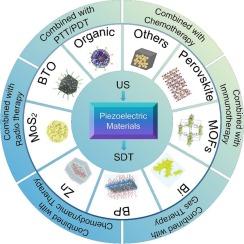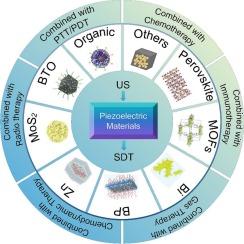Recent advances of piezoelectric materials used in sonodynamic therapy of tumor
IF 20.3
1区 化学
Q1 CHEMISTRY, INORGANIC & NUCLEAR
引用次数: 0
Abstract
Piezoelectric materials, recognized as unique functional materials due to their ability to interconvert mechanical and electrical energy, have demonstrated broad application prospects in the biomedical field. Particularly in cancer therapy, piezoelectric materials serve as sonosensitizers that generate internal electric fields under ultrasonic-induced mechanical force, modulating the migration of electrons and holes, and subsequently triggering surface redox reactions to enhance the efficacy of sonodynamic therapy (SDT). SDT, as an emerging non-invasive treatment modality, showcases distinctive advantages such as high tissue penetration, strong spatiotemporal controllability, and low treatment costs due to the synergistic interaction between ultrasound and sonosensitizers. This review systematically discusses various types of piezoelectric materials, with a focus on the recent research progress, mechanisms of action, and optimization strategies of novel materials like perovskites in the SDT domain. Additionally, the applications of piezoelectric materials in the combined treatment of SDT with other therapies are introduced, and the prospects and potential of these materials in tumor sonodynamic therapy are highlighted. By delving into the fundamental principles of the piezoelectric effect and its mechanistic role in SDT, this review offers new perspectives and insights into the biomedical applications of piezoelectric materials.


用于肿瘤声动力疗法的压电材料的最新进展
压电材料是公认的独特功能材料,具有机械能和电能相互转换的能力,在生物医学领域具有广阔的应用前景。特别是在癌症治疗领域,压电材料可作为声敏剂,在超声波诱导的机械力作用下产生内电场,调节电子和空穴的迁移,进而引发表面氧化还原反应,提高声动力疗法(SDT)的疗效。作为一种新兴的非侵入性治疗方式,声动力疗法具有组织穿透力强、时空可控性强、治疗成本低等独特优势,这得益于超声波与声敏化剂之间的协同作用。本综述系统地讨论了各种类型的压电材料,重点介绍了 SDT 领域中包晶石等新型材料的最新研究进展、作用机制和优化策略。此外,还介绍了压电材料在 SDT 与其他疗法联合治疗中的应用,并强调了这些材料在肿瘤声动力疗法中的前景和潜力。通过深入研究压电效应的基本原理及其在 SDT 中的机理作用,本综述为压电材料的生物医学应用提供了新的视角和见解。
本文章由计算机程序翻译,如有差异,请以英文原文为准。
求助全文
约1分钟内获得全文
求助全文
来源期刊

Coordination Chemistry Reviews
化学-无机化学与核化学
CiteScore
34.30
自引率
5.30%
发文量
457
审稿时长
54 days
期刊介绍:
Coordination Chemistry Reviews offers rapid publication of review articles on current and significant topics in coordination chemistry, encompassing organometallic, supramolecular, theoretical, and bioinorganic chemistry. It also covers catalysis, materials chemistry, and metal-organic frameworks from a coordination chemistry perspective. Reviews summarize recent developments or discuss specific techniques, welcoming contributions from both established and emerging researchers.
The journal releases special issues on timely subjects, including those featuring contributions from specific regions or conferences. Occasional full-length book articles are also featured. Additionally, special volumes cover annual reviews of main group chemistry, transition metal group chemistry, and organometallic chemistry. These comprehensive reviews are vital resources for those engaged in coordination chemistry, further establishing Coordination Chemistry Reviews as a hub for insightful surveys in inorganic and physical inorganic chemistry.
 求助内容:
求助内容: 应助结果提醒方式:
应助结果提醒方式:


